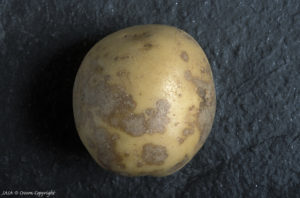Jun 28, 2018Consumer trends puts spotlight on blemish diseases
It’s not a surprise that the market for colored potato varieties, (red and yellows as well as fingerlings) has been on the rise in the last several years. What may be less obvious are the effects those market trends have on managing diseases.

In the Red River Valley that means being more vigilant for blemish diseases like silver scurf.
“We’ve got a great red market here in the valley and people are buying these table potatoes by eyesight. You know, they’re buying them by the way they look,” said Gary Secor, plant pathologist with North Dakota State University.
He said as more specialty varieties come in from Europe and South America, including fingerlings, the look of those potatoes is even more important with consumers. As consumers become pickier, Secor said, that translates to pickier buyers and the producers have to become more selective as well.
“Blemish is becoming more and more of an issue because of the specialty crop and that market is increasing,” he said.
While researchers have long experience with domestic varieties, and knowing which are more susceptible to diseases like silver scurf, the influx of those specialty varieties, including European breeds, poses management challenges since they don’t know how the varieties will react to silver scurf
“It’s hard to keep track of which varieties are more susceptible than others. We don’t have any really good resistant varieties but we do have varieties that are way more susceptible,” he said. “Until someone grows them, people buy them and they get rejected, we really don’t know if they get silver scurf or not.”
When dealing with blemished potatoes, there may be different diseases responsible for the damage. Secor said the main culprits in his area are silver scurf, black dot and silver patches. While there are management practices, mainly seed treatments for silver scurf, there currently are no effective management tools for black dot.
“That’s really going to be a tough nut to crack,” he said.
Secor said researchers are looking at using biological agents and also soil fumigation with chloropicrin, which has shown to effective in Europe but so far has not been successfully implemented in the U.S.
-Scott Stuntz, managing editor







